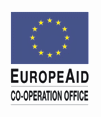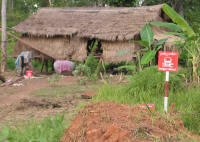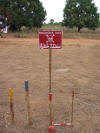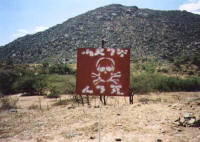Landmines Problems & Strategy
 About Antipersonnel Landmines (APL)
About Antipersonnel Landmines (APL)
International dimension On 1 March 1999, the "Convention on the Prohibition of the Use, Stockpiling, Production and Transfer of Anti Personnel Landmines, and on their Destruction" (hereafter referred to as "the Ottawa Convention") entered into force. This event marked the culmination of several years of intense political activity to galvanise the international community into concerted action to overcome the tragedy of antipersonnel landmines. As of December 2005, 147 States had formally agreed to be bound by the Convention. However, several key states have not yet signed. The process includes national measures to sign and ratify the Convention through the deposit of a declaration with the United Nations Secretary General indicating adherence to the Convention.
On 1 March 1999, the "Convention on the Prohibition of the Use, Stockpiling, Production and Transfer of Anti Personnel Landmines, and on their Destruction" (hereafter referred to as "the Ottawa Convention") entered into force. This event marked the culmination of several years of intense political activity to galvanise the international community into concerted action to overcome the tragedy of antipersonnel landmines. As of December 2005, 147 States had formally agreed to be bound by the Convention. However, several key states have not yet signed. The process includes national measures to sign and ratify the Convention through the deposit of a declaration with the United Nations Secretary General indicating adherence to the Convention.
For more information about the status of the Convention, please visit: http://www.gichd.ch/213.0.html
Obligations under the Ottawa Convention: The entry into force of the Convention is a major incentive to improved mine action as well as to a more structured approach with specific milestones to be reached. The obligations include:
Destruction of all stock-piled mines within 4 years (Article 4)
Destruction of APL in mined areas within 10 years (Article 5.1)
Identification, marking, and fencing of mined areas as soon as possible (Article 5.2)
Reporting to the UN Secretary General within 6 months on the domestic APL situation (Article 7), provision of information for the UN database (Article 6.6), and co-operation in measures to verify compliance (Article 8)
Taking the necessary legal, administrative, and other measures to prevent activities prohibited under the Convention (Article 9).
Responsibility for mine action firstly lies with the government in an afflicted country and this factor should guide the definition of the donors’ interventions. However, in a post-conflict situation, it is unlikely that effective governmental structures exist to organise and direct rehabilitation and reconstruction, and resources available for mine clearance are often limited. The creation of national policy institutions and the establishment of local operational demining capacity, free from partisan influence and other vested interests, will therefore be essential prerequisites for mine action programmes in each of the afflicted countries. Many of those afflicted countries which are Party to the Convention require assistance in fulfilling their obligations, and this will be a priority for international action over the coming years in accordance with Article 6 of the Convention. Over the past years, there has been a growing international awareness of the tragic impact of APL on the populations in many regions of the world struggling to recover from the effects of armed conflict. In addition to the continuous toll of victims, economic and social recovery has been impeded by the actual or suspected presence of APL. Mine Action has therefore become an urgent priority in post-conflict situations in order to prevent casualties and facilitate the return to normal living conditions.
Over the past years, there has been a growing international awareness of the tragic impact of APL on the populations in many regions of the world struggling to recover from the effects of armed conflict. In addition to the continuous toll of victims, economic and social recovery has been impeded by the actual or suspected presence of APL. Mine Action has therefore become an urgent priority in post-conflict situations in order to prevent casualties and facilitate the return to normal living conditions.
Mine Action" is a generic term referring to all activities, including mine risk education, advocacy, information management, victim assistance and rehabilitation, survey and marking of suspected areas, area reduction, detection and identification of landmines, training of specialist personnel, as well as demining (i.e. mine clearance to humanitarian standards), stockpile destruction, which contribute to the reduction of the human, economic, and environmental impact of anti-personnel landmines, unexploded ordnance (UXO), and other hazardous debris of war.
European dimension
The European Union is now recognised as one of the leading contributors to mine action within the international community. In the period 1992-2000, the Community committed around € 240 million to these tasks world-wide. In the last 5 years, the European Union has contributed more than € 700 million to mine action. In addition, during the same period, European Union Member States carried out bilateral actions on a similar scale. The European Union is supporting actions in all of the most-afflicted countries, including Bosnia and Herzegovina, Croatia, Serbia and Montenegro (Kosovo), Afghanistan, Iraq, Cambodia, Laos, Sri Lanka, Angola, Eritrea, Ethiopia, Mozambique, Nicaragua, Somalia and Sudan. In many of these countries it is the major contributor to mine action.
European legislation on antipersonnel landmines In July 2001, the European Parliament and the Council adopted two Regulations EC/1724/2001 and EC/1725/2001 concerning action against antipersonnel landmines explicitly based on the Ottawa Convention. It defines the objectives and priorities of EC action as well as the types of activities that can be co-financed by the EC.
In July 2001, the European Parliament and the Council adopted two Regulations EC/1724/2001 and EC/1725/2001 concerning action against antipersonnel landmines explicitly based on the Ottawa Convention. It defines the objectives and priorities of EC action as well as the types of activities that can be co-financed by the EC.
The principal objectives of EC mine action as laid down in the Regulations shall be:
To support the elaboration, monitoring and implementation of a civilian demining strategy;
To assist afflicted countries in the implementation of their obligations under the Ottawa Convention;
To create and sustain national structures and local capabilities within the afflicted countries to carry out mine actions with maximum effectiveness;
To respond to humanitarian emergency, prevent casualties and assist the rehabilitation of mine victims, in exceptional cases also in States which have not acceded to the Ottawa Convention;
To support the in-country trial and introduction into operational use of appropriate mine action equipment and techniques;
To promote coordination with end users of the demining equipment at the early stages of research and to support the use of these technologies in the poorest mine-affected countries;
To encourage demining actions that are compatible with the local environment and consistent with the sustainable development of the affected region;
To support coordination among international mine action players.
The regulations also provide that the Commission should define regularly a multiannual strategy and programming document concerning mine action.
After the adoption of the regulations, the Budgetary Authority decided to foresee a stable level of funding credits on the thematic budget line for actions relating to Anti-personnel landmines. Under budget item 19 02 04, the European Commission has the possibility to co-finance operations in favour of developing countries and third countries other than developing countries that help these countries in the fight against antipersonnel landmines.
EC Mine Action Strategy for 2002-2004 On 3 December 2002, the European Commission adopted the EC Mine Action Strategy for 2002-2004, as well as a detailed Multi-annual Indicative Programming, which will mobilise through various Community instruments (budget lines for antipersonnel landmines, geographic programmes, ECHO and Rapid Reaction Mechanism) approximately € 105 million over the period 2002-2004. Using these instruments in an integrated way, the EC is supporting mine action activities and as a consequence the economic and social rehabilitation of demined regions and resettled populations.
On 3 December 2002, the European Commission adopted the EC Mine Action Strategy for 2002-2004, as well as a detailed Multi-annual Indicative Programming, which will mobilise through various Community instruments (budget lines for antipersonnel landmines, geographic programmes, ECHO and Rapid Reaction Mechanism) approximately € 105 million over the period 2002-2004. Using these instruments in an integrated way, the EC is supporting mine action activities and as a consequence the economic and social rehabilitation of demined regions and resettled populations.
Priorities in Strategy The Mine Action Strategy lays down the main priorities for EC mine action - to eliminate the danger of mines and unexploded ordnance and to limit their effects on affected countries and populations, through surveys, mine clearance, risk education and risk reduction, actual destruction of mines and stockpiles.
The Mine Action Strategy lays down the main priorities for EC mine action - to eliminate the danger of mines and unexploded ordnance and to limit their effects on affected countries and populations, through surveys, mine clearance, risk education and risk reduction, actual destruction of mines and stockpiles.
Capacity building is encouraged at local and national level (in particular through the empowerement of the beneficiary countries), as well as actions aiming at increasing mine action efficiency.
Parallel to these thematic priorities, geographic priorities make it possible to determine focus countries or regions for EC financing, according to the seriousness of the mine situation in the country, to the priorities established by the affected countries themselves in their national indicative programmes, and to the efforts made in relation to the Ottawa Convention, in particular as regards ratification.
This Strategy integrates and complements the existing country strategies agreed with third countries and with other partners of EU mine actions all around the world.
By adopting this strategy the European Commission enables the EU to better respond to emerging crises and to new humanitarian needs.
- Administrador's blog
- Login to post comments




